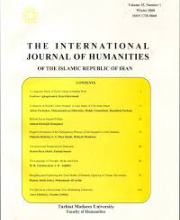۱.
The aim of this paper is to develop a prediction model of energy demand of Iran’s industrial sector. For that matter a Markov Chain Grey Model (MCGM) has been proposed to forecast such energy demand. To find the effectiveness of the proposed model, it is then compared with Grey Model (GM) and regression model. The comparison reveals that the MCGM model has higher precision than those of the GM and the regression. The MCGM is then used to forecast the annual energy demand of industrial sector in Iran up to the year 2020. The results provide scientific basis for the planned development of the energy supply of industrial sector in Iran.
۲.
The Mesopotamian mythology represents a variation of monsters and hybrids. Among them, the fantastic creatures in the composition of the animal and the man are very important; it is about the "man-animal". What attracts our interest; it is the composite creature, the "man-bull", because of its diverse aspect, as well as its symbolic characteristic. On the other hand, we notice one of the very practical figures and very renowned, "Master of animals", it is appreciated as much as all the Mesopotamian regions represented it in their arts. Problematic: what types of the "man-bull" had most importance in Mesopotamia? Which is the relationship enters the "man-bull" and "Master of animals"? What physical evolution arose during the transformation of the "man-bull" to "Master of animals"? Hypothesis: there is doubtless a narrow relation enters the "man-bull" and "Master of animals ", as regards the symbolizing character to be able to it and their appearances in vertical position. Mesopotamia represents a particular character of the real or fantastic animals, which spread towards the other parts of the country; it is about the representation of animals in vertical shape.
۳.
In this paper we try to give a description of the juridical status of religious minorities, Muslim or otherwise, in the constitution of the Islamic Republic of Iran. We also deal with the question of whether non-Muslim minorities are free to perform their religious practices and the extent of their freedom.
۴.
The Khānegāh or the Shrine of Shaikh Safi al-Din in Ardabil, north-west of Iran, listed as the world heritage site ( by UNESCO) back in 2011 under the identification no. 1450. This ensemble is located at 38° 14´52/5" northern latitude, 48° 17´27/5˝ longitude, and altitude of 1365 above sea level in the center of city of Ardabil. The ensemble of Shaikh Safi al-Din is a well-developed prototype constituting social, religious, charitable, cultural, and educational functions. With range of versatile spaces, it has met the physical and spiritual needs of residents and pilgrims as such; it includes places to meet needs in fields of education and training, livelihood and healthcare. Relying on the diagram of De Morgan, it seems there are more than 67 spaces and courtyards attached to the Khānegāh, all of which have had a significant role in the training and educational philosophy of Safavid tradition. After decade of Safavid, most part of this magnificent structure damaged. F. Sarre, a German researcher, conducted one of the earliest studies on the architectural and archaeological history of Ardabil shrine in 1897. Some others such as Dibaj (1948), Ali Akbar Sar-faraz,(1974), Weaver (1974), Morton (1974) and Seyyed Mahmoud Mousawi (1995-6) have also carried out researches on this subject in recent decades. Archaeological works of Cultural Heritage and Tourism Organization of Islamic Republic also conducted a study under the leadership of Hassan Yousefi in 2007. These studies cleared so many unsolved historical questions about the general plan of the holy shrine.
۵.
The main sources of all natural light are the sun, the moon and the stars. In other words, the principle source of illumination is the light as mediated by atmosphere. According to some philosophers, spiritual or holy light includes not only material and quantified aspect, but being non-physical properties it treats as a spiritual connector between god and man. The light is the main part of existence which not only contacts to the surface of objects, but also helps them form. In other words, light is the key of finding space fundamental in making holy places meaningful. The present paper tries to make a comparative analysis of lighting in some of the most famous sacred buildings around the world. As such, the methodology preferred in this piece of research is descriptive, analytic and comparative.
۶.
Today, there is a plethora of literature on the process of accelerating growth of science and technology in Iran. Assuming technology as a social construct of modern society, and in the light of Ricoeurian hermeneutic approach, this paper aims, first, to show the resemblance of the current discursive relationship between the Iranian society and technology to a "discourse of faith" and, second to explain how this discourse has roots in the preceding one which can be considered as a "discourse of suspicion". To do so, the paper first, builds a conceptual model based on the Ricoeurian theory of interpretation, where, by analogy, modern technology is compared to the text and the user of the technology as its reader. Then, it introduces two episodes of relationship between technology and its Iranian users in the public policy of the post-revolutionary era: distanciation and appropriation. It concludes that the current growth of scientific endeavors serves as the material base for an Iranian discourse of techno-nationalism; a new self-identification which motivates the elites to develop new bases for national self-esteem.
